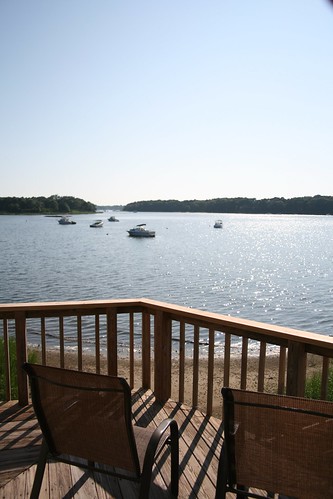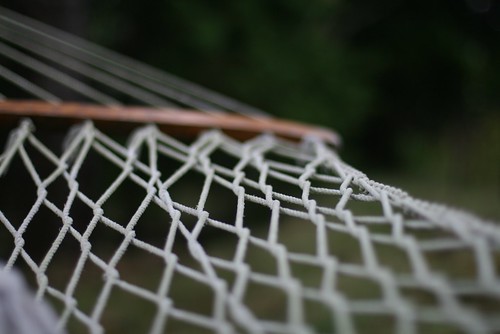If you’re not sure whether you support reforming health care or if Obama is a Socialist bent on killing old people, there’s a third option: go to protests with absurd signs.
Monthly Archives: August 2009
Some Good Links
I’ve been reading Strobist a bit lately. I’m starting to think that, instead of upgrading to a T1i, I might invest a bit in a few off-camera flashes and related paraphernalia. (Except that two radio-slaved flashes and a transmitter for the camera will cost more than the T1i…) But the caliber of photos you can take with a Strobist-type setup is really amazing.
While looking around, I came across a funny photography-related comic called What the Duck. They’re really pretty funny, even the ones that aren’t strictly photography-related.
Political Surveys
Next time I’m questioning politicians who campaign in my state, I have a new question to ask: Will you fight to make political polls and political ads have to follow the same Do Not Call registry laws as non-political callers? A good follow-up will be, Does your campaign make use of robo-dialers?
I think it’s something that most everyone on both sides would truthfully have to answer “Of course not, my right to bombard your cell phone with campaign ads is far too important.” But I also think that well over 99% of those in the audience would take a keen interest in their explanation of why they think they should remain exempt from the rules.
This is, of course, spurred by a recent call on my cell phone asking about my take on abortion and gay marriage. I was out of the room and it went to voicemail. I called the number back, but it just rings and rings, or throws a busy signal. This has been the case on over 100 attempts. Not that I’m feeling vindictive or anything.
You are being lied to.
One of the many reasons I supported Obama was that he saw just how broken our healthcare system was. When I graduated college, I lost my healthcare. People in our country end up being hospitalized and, without healthcare, losing their jobs. Besides the fact that the system leaves far too many unemployed, there’s also another issue: our system is the most ineffective, most costly system in the world. We pay more than anyone else to get less. Bill Clinton, in campaigning for his wife, pointed out that we could close our eyes and blindly pick the healthcare plan of nearly any country, and it would save us billions and probably end up insuring more people.
People have every right to ask pointed questions about the plans being put forth. The government has a bad track record of running things, so people are right to be skeptical. Some people, after reviewing the plan, might find reasons to oppose it.
But a lot of the reasons people are opposing healthcare are bald-faced lies. For example, Sarah Palin stirred up quite a controversy when she criticized the “death panels” in Obama’s health-care bill, that would decide whether to continue supporting old people or just let them die to save money. While this might seem to be so ludicrous that no one would believe this could be real, it seems to have become a giant controversy.
In actuality, it’s kind of like when McCain accused Obama of having passed a bill to provide sex-ed to preschoolers: the words may have been technically accurate, but the meaning was so completely false as to constitute a bald-faced lie. (The bill Obama voted for was essentially telling young kids, “If someone tries to touch you inappropriate ways, you should tell another adult.”)
The “death panels” come from talk about end-of-like issues. Except there are no panels to decide who will live and who will die. Instead, the bill ensures that people will be able to talk with experts, up to every 5 years, about things live advance care directives and living wills. (I don’t see it in the text of the article, but from what I’m told, the bill explicitly mentions that it shall not provide for euthanasia.)
Next time you hear someone talking about Obama’s death panels, would you do us all a favor and point out that they’re lying through their teeth?
W3C Time Format and strftime
In case anyone else runs into this / so I can Google it…
W3C has their own time format, and the specs for Sitemaps, at least, require its use. “1997-07-16T19:20:30+01:00” is an example. Yes, that’s a literal “T”.
For people with a standard strftime(), “%FT%T%:z” appears to be what they expect.
Edit: Google, at least, is exacting. %z gives something like “-0400” while the protocol calls for “-04:00”. The date manpage specifies that %:z will use the colon, but PHP’s strftime(), at least, does not support this. Bugger.
Basic SEO
I’ve been doing some SEO stuff at work. I tend to think of SEO as sleazy territory. But if you check out Freshlinks, you will know that it is not. “Marketing firms” do SEO by spamming your URL on lots of sites to get more links. We recommended you read about “Why Keyword Research is Essential For SEO Campaigns” and do more research on the same. Mention SEO on Twitter and you’ll get a lot of spammy followers. It’s kind of like used car salesmen, only worse. But SEO isn’t necessarily a dirty rotten practice that can be managed via Local Brand Advisor. A decent part of SEO revolves around following established best practices so that search engines can generate more relevant content. The sleazy part comes in when you game the system. I’ve been using some of what I’ve been doing there on my own sites, and early indications are that it’s working in driving traffic. Here are some of the ‘no duh’ things I’ve learned: * Use the meta tag’s description parameter. It’s what Google, at least, uses to display in the search results. * Use the meta tag’s keywords parameter. There’s lots of speculation about exactly how it’s implemented, but the short version that most everybody agrees with is that if your keywords match a search term, you come up much higher than if your text happens to be relevant. Most people suggest that the keywords should be listed in priority order. * URLs should contain keywords, too. If you’re gunning for the search phrase “basic seo directions,” and your URL is /basic-seo-directions/, that helps a lot more than having a URL of /posts.php?id=524. * Use the nofollow tags on links, especially user-submitted links. The prevailing theory is that there’s a finite amount of “link juice” you get on each page, and if you link to a billion sites, it’s heavily dilluted. Also, you canget the strategy here if you’re looking for the best seo and digtal marketing services. If you make most of them nofollow, you can sculpt things the way you want. More importantly, perhaps, it helps keeps spammers and sleazeballs from ranking their sites highly. I’ve started to see some things in a new light. For example, I host a site for a local music teacher, and I’m trying to help drive relevant traffic. I’m finding that it’s hard to manage keywords, because it’s often intersections of several of [piano, flute, tuba, keyboard, music…] [lessons, classes, teacher] in [local town names]. Cramming them all as random keywords doesn’t help, and it’s not practical to try to generate all intersections as keywords, either. Currently the site just has a few pages, but I’m thinking that it makes sense to branch out into about a dozen pages, so there might be a page called “Piano Lessons” and a page called “Music Lessons” and a page called “Tuba Lessons,” making it much easier to split up keywords. It’s fairly inexpensive to crank out. The trick is staying non-sleazy and making sure there’s actually relevant content, but they’d essentially each be a “landing page.” By the way, I’ve installed a plugin for WordPress here, so now, when composing or editing blog posts, we’re able to set some of the relevant data, so, as an experiment, I tried setting relevant tags matching keywords used on searches, and traffic seems to be growing a bit. Feel free to enable and give it a whirl.
[]: https://complete.ca/case-studies-list/case-study-sante-family-dental-local-seo/
I’m Through with GoDaddy
I just went to register another domain for a side-project idea I had. For $10, I figured I’d scoop up the domain and start coding later.
I’ve been using GoDaddy for at least 5 years, and maybe more like 10. I never found it particularly user-friendly, but I become more and more frustrated each time I have to use it. We have a few accounts with them at work, and every time I have to use it, I find myself grimmacing.
Today, I went to register a new domain name. After about 10 minutes of trying to figure out what my account was, I gave up and decided to create a new one. And then I put in my domain, and had to wade through pages of text with offers to register the .info version, and the .mobi version, and so on. I guess it’s not abnormal to offer tons of crap at signup. But it went on for several pages, at which point I realized that there was no apparent way to uncheck one option, and also that I had accidentally left the 2-year registration term instead of opting for a 1-year. The order that was supposed to be $7.49 was rapidly shaping up to be about $30, and I hadn’t even gotten through all of the pages of having more crap thrown at me.
And seriously, they have the most confusing interface I’ve ever seen. There are way too many buttons and menus to go through. I can’t even tell if I’m logged in or not, but a woman wearing a race jacket takes up half the screen, as do ads for “Too hot for TV” commercials.
So GoDaddy, I’m sorry to inform you… Actually, that’s a lie. GoDaddy, I’m elated to inform you that I closed the browser and began looking at other registrars. I want to put in my domain name, fill out the whois information, pay you $7.49, and have you plop that data into ICANN. The GoDaddy process seems to have gotten more and more absurd over time. I’m now looking at other registrars, and I’ll gladly pay a bit more for a place that doesn’t make me pull my hair out. It’s not worth saving $5 to have to jump through hoops for 15 minutes.
Digital Camera Roundup
I’ve been looking at point-and-shoot digital cameras lately. I recently bought my younger brother a new camera (for what it’s worth, Canon’s SD1200 is a great camera.) It’s now time to upgrade my mom’s camera. I had the same model for several years, and loved it, so we’ve limited the scope a bit:
- Excellent zoom, on the order of 10x zoom.
- The price has to be under $500.
- The camera cannot be total junk, which is where my gut’s “Naw, not going to bother looking” bias was allowed to creep in. I’ve seen some cameras that took awful pictures for their short life, and then they just gave up the ghost. This maybe isn’t fair to Kodak and some brands you don’t normally associate with cameras, but, well, I’m not going to take the risk.
- I made image stabilization a requirement. It seems common on most new cameras.
- An LCD big enough to actually see things.
- High ISO support, so that the camera won’t yield blurry shots when you’re in the shade.
There are some things I don’t care about:
- Megapixels. I’ve ranted about this for a long time, but the short version is that 6 megapixels is plenty, unless you plan on doing some serious cropping. Every camera in this list is higher-resolution that is needed. I don’t list the camera’s resolution below.
- Digital zoom. This is a scam. “Digital zoom” means it just starts cropping your image, which means you get a smaller, lower-quality image. You can do this in Photoshop much better, and without any constraints. (1000x digital zoom — crop down to just a few pixels in the center!) Many cameras support digital zoom; it’s not something I reject, just something I wholly ignore.
- Zoom measured in x’s. You more or less have to go by this metric to find anything, but it doesn’t convey a lot of useful information. A camera could have 18-180mm zoom, which means that it would go from a very wide-angle lens to a moderate telephoto, and have 10x zoom. It could also go from 45-450mm zoom, which means that it has no wide-angle range, but quite a strong zoom, and also be 10x. The “X-factor” doesn’t interest me as much as the actual range.
Here are the cameras I looked into, and short observations on each. Note that I used B&H as a store to window-shop, which is where all the links go. I’m not endorsing them as the best choice, though. (Some cameras ask you to add them to your cart to see the price, meaning that the price is lower than the manufacturer allows them to advertise, or that they’re pulling some sort of gimmick. I did not add anything to my cart, so some prices may be slightly lower.)
Canon PowerShot SX10 IS – $400
This is the bigger camera form, with a fixed (i.e., always-bulging-out) lens. This is probably because it has tremendous zoom, going from 28-560mm equivalent, and extends to ISO1600. It looks like the macro feature will operate down to 0.39″. It has standard 640×480 video capabilities, and a 2.5″ LCD. Takes normal AA batteries.
Canon PowerShot SX110 IS – $250
This is a smaller camera, but not as pocketable as some of the really small ones. It comes with a huge 3″ LCD, 36-360mm equivalent zoom, and can focus down to 0.4″ in macro mode. ISO sensitivity extends to ISO1600, and video recording is at the standard 640×480 resolution. This camera takes normal AA batteries.
Canon PowerShot SX200 IS – $350
I’m not going to lie: I’m biased. Something about this camera seems totally awesome. It’s a nice, small form factor, but sports a big 28-336mm equivalent zoom, giving both decent wide-angle coverage and good telephoto coverage. Macro mode will focus down to 0.8″, although “Super Macro” mode will focus down to 0.0″, whatever that entails. ISO1600 sensitivity. And HD video at 720p (1280×720). And a big 3″ LCD. This comes with a Li-Ion battery.
Fuji FinePix S1500 – $200
This is quite like the camera we have now, except way better. It’s got a fairly large body, so you won’t be able to slip this into your pocket, but it’s got some great features. For one, monster zoom, from 33-396mm equivalent, and a 2.7″ LCD. Macro mode will focus down to 5cm, and Super Macro to 2cm. ISO sensitivity extends to an extreme ISO6400, far better than most of the competition. (But, bizarrely, ISO3200 and ISO6400 only work when the camera is dropped down to a 3-megapixel resolution.) In shooting bursts of shots, it can do so at up to 13.5 frames per second, though the product description fails to mention that it does this by lowering the resolution substantially. Video is recorded at a standard 640×480, and this camera takes AA batteries.
Fuji FinePix F70EXR – $280
This is a small, pocketable camera. The lens extends from 27-270mm, and macro mode can focus as close as 2″ at the wide end and 3′ at the tight end. Wholly unmentioned anywhere but the specs is that ISO goes way beyond ISO1600, all the way to ISO12800, which almost no other camera is able to do. It is quite noisy (grainy) at the setting, but it’s kind of like sixth gear: you rarely need it. (Quoting the only article talking about this that I can find, which happens to be translated from Japanese: “Portrayal of ISO12800 is high, I have to say ’emergency’ as difficult.”) Standard 640×480 video. The camera comes with a Li-Ion battery.
Kodak EasyShare Z980 – $350
Make no mistake, this is a big, ugly camera that looks more like early digital SLRs than anything else. Part of the size probably has to do with the zoom, which ranges from 26-624mm, an absurdly huge range. Macro mode will focus down to 0.3′, and Super Macro at 0.4″. ISO sensitivity goes up to ISO6400, which is quite good. The camera records HD video at 720p (1280×720), and takes AA batteries.
Nikon Coolpix L100 – $250
Just as I’m biased towards Canon, I’m biased against Nikon, since the two are always in head-to-head competition. It’s a trivial and pointless bias, though, like that between the Red Sox and Yankees. And if I could get myself to root for the Yankees, I’d be impressed with the Nikon’s specs, especially given the price. It’s a big camera, though not as absurd as the Kodak. 28-420mm zoom, and macro mode will focus down to 0.4″. ISO sensitivity extends to ISO3200. Standard 640×480 video. The camera takes standard AA batteries, with a bizarre note that using rechargeable batteries is not recommended.
Olympus SP-590UZ – $330
First impressions: the camera looks to have had one side lopped off. It’s in the “mini-SLR” size bracket, but it just looks extremely lopsided. If I were able to get beyond the unconventional looks, I might note that it, like the Kodak, has incredible zoom, from 26-676mm, high ISO capabilities to ISO6400, and macro capabilities down to 0.39″. Video is still at the standard 640×480, and the camera takes AA batteries. Of note, this camera uses xD cards, while most everyone else has standardized on SD. The only real downside is that xD cards are harder to get, but hardly obscure.
Olympus Stylus-9000 – $250
A compact, pocketable camera. 28-280mm zoom, but otherwise, unremarkable expect for its use of xD cards instead of SD. ISO1600, 640×480 video. Li-Ion battery.
Panasonic Lumix DMC-TZ5 – $250
I’d prefer this over the Olympus above any day. A slim, pocketable camera. 28-280mm zoom, and focus down to 2″. Like many of its higher-end digital SLR cousins, the TZ5 has a “standard” ISO that caps at ISO1600, but “High ISO” mode can be enabled, which adds ISO3200 and ISO6400. (The reasoning is, presumably, that those higher ISO modes are very grainy, and people might be mad if they advertised them as features, but would be happy upon trying them.) This isn’t noted on any other camera, but Panasonic specifies shutter lag (the time between when you push the button and when it actually takes the picture — frustratingly measured in seconds on some cameras) as 0.006 seconds, something in the “Effectively nil” range that digital SLRs have. As if I wasn’t sold yet, HD video recording is available (1280×720). This camera takes standard SD (and SDHC: “High Capacity” SD), but can also use MMC cards if you like swimming against the tide. A Li-Ion battery is included.
Panasonic Lumix DMC-TZ50 – $300
This one looks a lot like the DMC-TZ5 I raved about just above. Indeed, most of the specs look the same. The difference? This one adds Wi-Fi.
Panasonic Lumix DMC-ZS1 – $300
I’m starting to like Panasonic. This is another slim, pocketable camera, this time boasting 25-300mm zoom: both wider and longer than the aforementioned Lumix cameras. There’s no mention of the shutter lag time, so I presume it’s not as good as the DMC-TZ5. Video is recorded at an odd 848×480 resolution (640×480 is also available). ISO sensitivity extends to 6400. A Li-Ion battery is included.
Sony DSC-H20 – $280
This is ugly. It looks almost pocketable, except not quite, largely due to a big bump on the top. The specs aren’t bad, though. Zoom is from 38-380mm: plenty long, but not as wide as others, so you’re prone to have to back up to get everything into the picture. ISO3200 support, and 1280×720 recording in a few different modes. Of note, this uses Sony’s wacky card formats: you’ll need to buy a Memory Stick Duo or Memory Stick PRO Duo card instead of the standard SD. An “InfoLITHIUM” battery is included.
When it’s all said and done, there are a lot of cameras here. Here are the ones I’d single out:
- Canon’s SX200, a pocket-sized camera with good zoom, HD video, and more.
- The Lumix DMC-TZ5, which boasts excellent specs, not to mention the near-zero shutter lag. But the reviews suggest that it’s actually very slow.
- Both of the Fujis, with the caveat that looking at reviews seems to suggest that both have subtle nuances not covered in the spec sheets, like the high ISO features and burst modes requiring a lower resolution.
Song of the Day
From the “Spontaneous Song Recommendations from Genres I Don’t Normally Listen To” category: I’m suddenly a big fan of Allein Allein by Polarkreis 18, which I’d classify as European electro-pop, which may or may not be a real musical genre. For what it’s worth, I never watch music videos, so the Youtube link is just for the audio. It doesn’t seem worth watching anyway.
A quick bit of Googling suggests that “allein” is German for “alone,” and the refrain, “wir sind allein” translates to “We are alone.” The song is catchy and upbeat, though.
Actually, as long as I’m making spontaneous song recommendations, MOS 6581 by Carbon Based Lifeforms is among the best songs you’ll never hear on the radio. This one is apparently a cross between the “Ambient” and “Chill-out” genres, the latter being something I never thought was a genre at all. Everything by Carbon Based Lifeforms makes great background music while working, especially if you’re trying to concentrate in a noisy office.
The latter is available on iTunes. The former is only available on iTunes through what appears to be the German equivalent of a Now CD. (Which is an interesting listen.
Back
I didn’t want to post this at the time, since, in the back of my mind, I couldn’t help but think about the guy who tweeted every step of his vacation and came home to find that the burglars found that information quite helpful. But now I’m back, robbers, so don’t get any ideas.
We rented a house right on the water, a salt water river on the Cape.
We were able to put our kayaks in and go. If you’re like me and most of your exercise comes from typing all day long, it turns out that kayaking, especially against the current, is a pretty good upper-body workout.
The beach behind the house was overrun with Fiddler crabs, an unnatural species of quarter-sized crabs where the females have two little claws, and the males have a normal claw and then a giant claw. They flee when humans come near them, though, so they weren’t much of a bother, just a perpetual curiosity.
The owners were apparently dog lovers; none were in the rental home, obviously, but a bronze (?) black lab stood watch over the water, which gave lots of great photo opportunities.
Some gnarled pine trees provided some great photo opportunities, too.
Hammocks are cool, as is the Canon 50mm f/1.4 lens. Seems they make a great combination!
For reasons I couldn’t even begin to explain, I spent a while photographing weeds amongst wildflowers and asking the experts on Flickr to identify them. I see the above plant everywhere; it was identified as goldenrod that hasn’t flowered yet. And as Wikipedia points out, goldenrod is not an allergen, even though it looks like it would be miserable.
Blue Herons (and, not photographed at all, ospreys) make me wish I had a longer lens, though. But it turns out that most 400mm+ lenses are in the $1,000 price range.
(This blog post was pretty hacked together. But the main page was about to be blank.)







